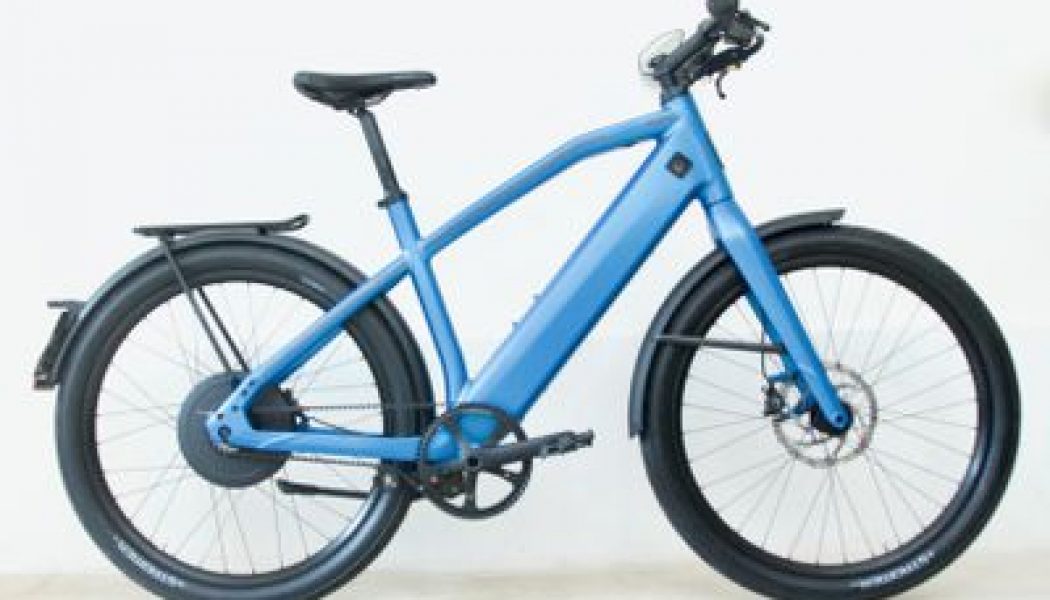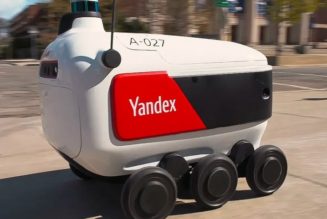The words “Swiss design” conjure images of luxury watch movements and delicately sculpted eyeglasses, not hulking e-bikes with thickly welded frames and face-melting power. Stromer is here to challenge those assumptions and force a rethink of how its Swiss-made electric bikes, with top speeds of 45 km/h (28 mph), can disrupt urban transportation for the benefit of residents. I’ve certainly seen the light after testing a new 2021 edition ST2, Stromer’s first e-bike with a carbon belt drive.
Broadly speaking, US cities have all of the fast e-bikes and no bicycle infrastructure, whereas European cities have all of the protective infrastructure and few fast e-bikes. It’s exceedingly rare to see fast e-bikes known as speed-pedelecs in my Amsterdam home, for example, where half of all new bikes sold are electric, and bicycles outnumber people by a lot.
It’s not that EU bike makers are an effete bunch of cheese-eating milquetoasts; they manufacture slow, underpowered e-bikes to avoid the draconian measures triggered by EU Directive 168/2013. It states that any e-bike that goes faster than 25 km/h (15.5 mph) with a continuous rated power above 250 watts is to be treated the same as a gas-guzzling moped. Makers of s-pedelecs like the Stromer ST2 are subjected to a grueling certification process that then requires owners to hold a moped-class driver’s license, liability insurance, and registration. By contrast, a similarly specced Class 3 e-bike in the US usually requires… nothing, other than a helmet.
To make matters worse, speed pedelecs are banned from riding on the vast majority of the ubiquitous bike lanes that famously protect helmet-less Dutch bicyclists in cities like Amsterdam. Why? Because mopeds are banned, and the law doesn’t differentiate. Fuck that. I wasn’t going to put my life at risk for this review by riding alongside heavy (and dangerous) automobiles just because European regulators can’t get their shit together.
Over the entirety of March, I spent my days fawning over the sophistication of the Stromer ST2 while fuming at lawmakers for holding back s-pedelecs from their full potential as car replacements. While I’ll be reviewing the ST2 on its own merits, it’s nigh impossible to recommend to Europeans without first considering the operational rules by which it’s constrained.
Before diving too deeply into why European rules suck, let’s start with what makes the new Stromer ST2 so good.
The ST2 is Stromer’s all-rounder model in a range of s-pedelecs that run from the entry-level ST1 to the ST5 (there is no ST4), with prices ranging from $4,199 / €4,628 to $11,699 / €11,428 and higher depending on configuration and options. Stromer’s motors range from 670W and 35 Nm of torque to 850W and 48 Nm. All Stromers are pedal-assisted e-bikes without throttles.
The ST2 starts at $5,699 / €6,128 and is fitted with a 750-watt Stromer CYRO Drive IG motor mounted on the rear hub. It produces a modest 40 Nm of torque to accelerate the bike up to 45 km/h (28 mph) from a standstill as safely and effortlessly as possible. A torque sensor ensures that power is delivered just as soon it detects a harder press on the pedal. The Gates Carbon belt drive linked to an internal five-gear hub propels the sturdy aluminum-framed bike forward on 27.5-inch wheels sporting high volume Cycl-e ST tires custom-designed by Pirelli.
:no_upscale()/cdn.vox-cdn.com/uploads/chorus_asset/file/22445572/verge_DSC_3547_2040pxl.jpg)
:no_upscale()/cdn.vox-cdn.com/uploads/chorus_asset/file/22445570/verge_DSC_3567_2040pxl.jpg)
:no_upscale()/cdn.vox-cdn.com/uploads/chorus_asset/file/22445581/verge_DSC_3470_2040pxl.jpg)
:no_upscale()/cdn.vox-cdn.com/uploads/chorus_asset/file/22445626/verge_DSC_3495_2040pxl.jpg)
My ST2 with the large-sized sport frame options came standard with fenders, a kickstand, and a mini rack; it did not come with the optional front and rear suspension. It weighs just shy of 33 kgs (72 pounds), which is undeniably heavy for an e-bike. But that mass makes the ride feel rock solid at top speed, without any worrisome wobble or flex when riding over bumps.
Safety is also boosted by custom front and rear hydraulic disc brakes, an electric horn, daytime running lights, and a Roxim Z4E Pro headlight that can produce between 600 and 900 lumens at night. (A dazzling 1600-lumen option is available.) There’s also an integrated brake light around back. The required rearview mirror is useful to see overtaking motorists on roads, but it makes the bike quite wide. This resulted in a few slapped car mirrors before I got a feel for the added width. Fortunately, the mirror folds to make it a bit easier to walk the bike through narrow hallways.
The keyless battery makes a pleasant “thunk” when ejected after a touchscreen and button combo.
My ST2 review bike came fitted with a 48V, 618Wh removable battery rated for up to 120 km or 75 miles, though I’d estimate real-world range for an aggressive rider like me is about half that. I managed just shy of 50 km (31 miles) with 10 percent charge remaining, according to the Stromer app, before deciding to top up. The ST2 has a customizable regenerative braking feature to make the most of the battery. That flat terrain I tested on didn’t benefit from the extended range allowed by the recuperation that’s possible on long steep declines.
I did about half of my testing while illegally riding on bicycle lanes because responsible individuals can regulate their speed for the slower flow of congested city riding. If a powerful Ferrari can share city roads with slower Hyundais, then certainly a powerful e-bike can share a dedicated lane with traditional bicyclists. Putting the ST2 into low-power mode makes this easy. My riding was an even mix of max power (setting 3) at max speed (up to 47 km/h, according to the integrated display) when commuting outside the city center, and lazy 20 to 30 km/h jaunts at low power (setting 1) around town. A beefier battery with a stated range of up to 180 km (110 miles) is also available.
The + and – buttons on the left grip make it easy to toggle between the three power modes, while the right grip is home to the shifter. The excellent 5-Speed Sturmey Archer shifter is smooth and reliable and conveniently works from a standstill.
The touchscreen display integrated into the top tube is the interface to a bike OS that’s overwrought, in my opinion, though some might like having access to every configuration option (and there are a lot) right on the bike. I do not, especially not when all that overhead makes the bike take 20 seconds just to boot, an eternity if you’re in a hurry. My bike was also configured to boot into a lock screen that was frustratingly slow to respond to the five taps required to enter my secret passcode. The display also easily washes out in sunlight.
In my experience, it’s rare to make any changes once a bike is set up to your liking, meaning it’s best to offload more advanced features to an app. I prefer simple displays that boot fast and serve as a simple dashboard for basics like power setting and battery remaining. Stromer’s app is already very complete, offering lots of ride statistics and bike diagnostics in addition to options to tune the ride to your preferred balance of speed, torque, and agility. (I rode exclusively with the default “standard” setting.) The Stromer OMNI app is one of the best e-bike apps I’ve used.
The ST2 is as high-tech as they come, fitted with Bluetooth to auto-lock / unlock the bike when in range, GPS tracking, and 3G data for over-the-air software updates. An anti-theft mode shuts off the motor and starts blaring the horn to scare off thieves.
S-pedelecs can nearly reach the 50 km/h speed limit of most European cities, which is why they’re often pitched as true car replacements. Traditional e-bikes can already replace car commutes for many, but their top speed of 25 km/h means you’ll have to accept an extended travel time (while getting outside for some exercise). To test this theory, I “raced” a friend to a golf course to the north of Amsterdam; he in his new Tesla Model 3, me on the Stromer ST2 with a six-club pencil bag slung over my shoulder. His 30-minute trip took me just 27 minutes, and I had to wait 5 minutes for a ferry to arrive. Technically, I cheated by occasionally riding at top speed on deserted bike lanes I wasn’t allowed to use… but should have been.
:no_upscale()/cdn.vox-cdn.com/uploads/chorus_asset/file/22445520/verge_DSC_4224__1__2040pxl.jpg)
Now, about EU directive 168/2013. As the name implies, it was conceived years before it was fully enacted on January 1st, 2017, which is part of the problem. It failed to anticipate the explosion of electric personal mobility devices we’ve seen over the last four years, especially in countries like the Netherlands where half of all new bicycles sold last year were electric. The directive splits e-bikes into two categories of “type approvals”: type L1e-A includes electric cargo bikes like the Carqon, while type L1e-B includes s-pedelecs like the Stromer ST2 and gasoline-powered mopeds. Any e-bike maxing out at 25 km/h and 250 watts of continuous power is exempt from the directive and treated exactly like a regular bicycle.
Type L1e-B vehicles are limited to a maximum speed of 45 km/h and maximum continuous rated power of 4,000 watts. It requires mopeds and s-pedelecs to be fitted with a rearview mirror, horn, brake light, and prominent license plate; while the owner must be at least 16 years of age, wear a moped-rated helmet, possess a moped (type AM) driver’s license, be covered by liability insurance, and pay to have the vehicle registered.
Critics like the European Light Electric Vehicle Advocacy group LEVA-EU argue that because it was designed primarily for mopeds with combustion engines, the current type L1e-B approval process is unnecessarily complex and burdensome for bike makers. S-pedelec manufacturers are required to comply with 1,036 pages of text, much of which is about moped safety and emission concerns that simply don’t apply to speed pedelecs. The result is higher costs passed onto consumers and curtailed adoption and innovation because… why would any company bother?
Because Europe is Europe, there’s often variance in how regulations are set into law in each member country. While I complain about s-pedelec access to bike paths in Amsterdam, at least some bike lanes still allow them, unlike other European countries. Conversely, Belgium gives owners the choice to ride their s-pedelecs on any bike path or any road with a maximum speed limit of 50 km/h. It’s policy is informed by an effusive in-country study from 2019:
The speed pedelec has the potential to be a sustainable alternative for cars with internal combustion engines for commuting purposes. For the Belgian case, commuting with a speed pedelec can solve problems regarding congestion and air pollution.
At the close of 2020, Stromer bikes registered in Belgium (4,061) were more than double that of my Dutch home (1,558), according to Bike Europe. And despite being the market leader for s-pedelecs throughout Europe, Stromer produced just 12,417 s-pedelecs in 2020, which is the same number of slow e-bikes Amsterdam-based VanMoof makes in a month. European S-pedelec demand is clearly being stifled.
So, what’s to be done?
The good news here is that the European Commission seems keen to address the regulations that currently govern e-bikes. In October, the EC asked TRL, a UK-based mobility researcher, to initiate a review of the EU’s type approval process required by EU directive 168/2013. TRL recently concluded its findings and recommended that s-pedelecs be moved out of the L1e-B moped category and into the far less restrictive L1e-A category. L1e-A type approvals currently cover 1,000-watt e-cargo bikes capped at 25 km/h and some vehicles with throttles.
It’s a positive sign but still “unfortunate” for s-pedelecs from the perspective of LEVA-EU. The advocacy group has been pushing for an entirely new set of vehicle regulations for zero-emission vehicles like e-bikes, standing scooters, and electric skateboards based upon weight and speed only, not maximum continuous power. LEVA-EU believes that vehicles with similar levels of kinetic energy should be subjected to similar rules. It would therefore distinguish between vehicles with a maximum speed of 25 or 30 km/h and those capable of 45 or 50 km/h, instead of trying to bend the current regulations dictated by Directive 168/2013 (and the related Machinery Directive) to the realities of modern transportation. While the TRL did recommend to “create a dedicated approval process for PMD [personal mobility devices] separate from Regulation (EU) No 168/2013 and the Machinery Directive,” it capped this at a max speed of either 25 or 30 km/h, thus excluding s-pedelecs from the PMD category.
The EC isn’t bound by TRL’s recommendations so we’ll have to wait until 2022 for it to reveal its legislative proposal. Even then, any proposal would have to be negotiated with the member states; a process that could go on for years before new legislation is enacted.
:no_upscale()/cdn.vox-cdn.com/uploads/chorus_asset/file/22445618/verge_DSC_3452_ps_2040pxl.jpg)
As much as I’d love to call for revolution and demand that urban commuters act on the moral obligation to disobey the unjust laws governing s-pedelecs in Europe, I can’t really apply the logic I used for a short-term review to long-term ownership — especially not with ST2 prices starting at $5,699 / €6,128.
If you’re in the US, then no problem. But anyone in Europe interested in owning the ST2 or any speed pedelec that falls under the current L1e-B type designation had better do their homework. Not only do you need to factor in local laws that might differ from EU rules, but also the costs to register and insure yourself for such a nascent and confusing transportation category.
The Stromer ST2 is easily the most sophisticated and thrilling e-bike I’ve ridden since I began reviewing the category back in 2016. It also did the rarest of things by letting me glimpse a better future that’s just out of reach.
S-pedelecs could help accelerate European initiatives to green our cities and reclaim all of that space allocated to idling cars. But that won’t happen until EU regulators first remove the barriers to adoption and then create incentives to get city-dwellers out of their cars, even the electric ones, and onto bikes like the Stromer ST2.
Photography by Thomas Ricker / The Verge












